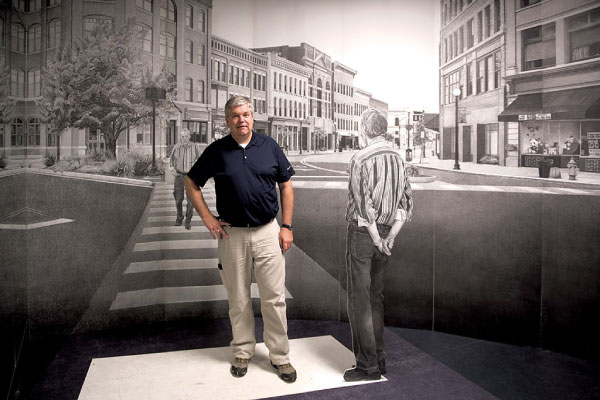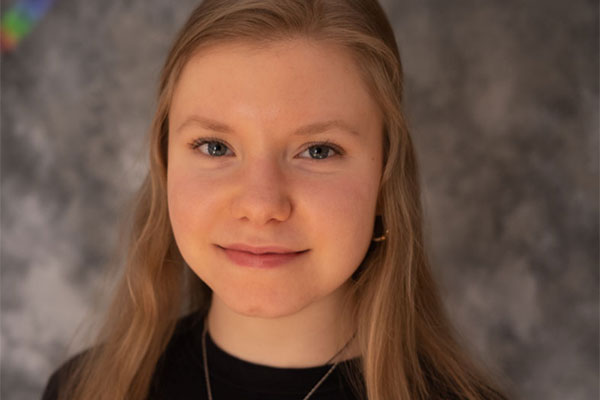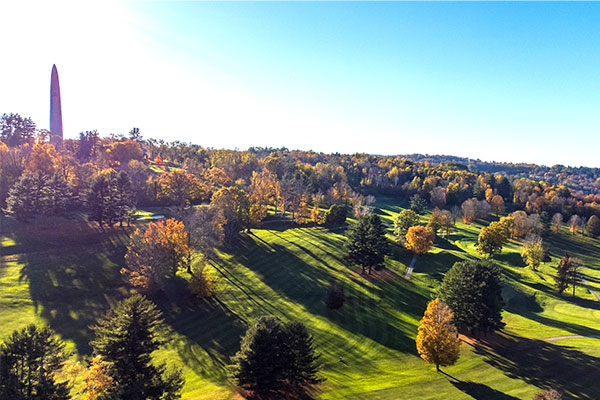By KEN PICARD
In a glass-walled studio high above Rutland’s Merchants Row, a Ukrainian-born artist swirled marble-like patterns onto paper. Across the hall, a painter from Texas worked on a floor-to-ceiling collage of doodles collected from Dallas museumgoers. Nearby, a Massachusetts multimedia artist pored over hundreds of photos she’d taken of Rutland.
In all, one morning last month, 14 painters, sculptors, photographers and other artists were at work in what one of them affectionately dubbed the “artists’ zoo” — a hall of fish-tank-like studios in the former Ripley Opera House. The long-vacant building now houses the 77ART Residency, a four-week program that gives emerging artists time and space to explore their craft.
By year’s end, 42 artists from 13 states and seven foreign countries will have visited Rutland for one of three monthlong residencies — the price of which is just $550 and a ticket to Rutland.
During the residencies, the artists create works and put them on display for the public, whom they invite in for artist talks and workshops. Some may later exhibit their works in the growing constellation of galleries around the city’s downtown.
The 77ART Residency was born out of an unusual alliance between Rutland businessman and property owner Mark Foley Jr. and retired Castleton University art professor and artist William Ramage. The residency is only the latest way in which Foley — with Ramage’s help — is turning empty commercial spaces into places to create and exhibit contemporary art, at virtually no cost to the artists themselves.
Rutland, a postindustrial city whose downtown has struggled for decades with the decline of traditional brick-and-mortar retail, now seems on the verge of an artistic renaissance. 77ART is so new it doesn’t have nonprofit status or a governing board. Yet it is helping to reshape the look and feel of Rutland and offering the city new hope of attracting more young residents.
“The face of downtown is changing. The face of retail is changing. What we need to focus on is experiential opportunities,” said Mary Cohen, executive director of the Rutland Region Chamber of Commerce. “We realize that if we’re going to invite people to come [to Rutland], you’ve got to have the arts.”
The Landlord and the Art Professor
A modest man who downplays his contributions to Rutland’s art scene — “I’m the smallest piece of the puzzle,” he said — Foley has made it possible for dozens of budding artists from Vermont and around the world to create and exhibit their work. At one point last year, he estimated, he was hosting 35,000 square feet of gallery space, all of which was rent-free.
It’s a way to contribute to the life of his city, he said.
“When you get 150 people at an art opening, it feels like you could be down in SoHo,” Foley remarked, referring to lower Manhattan’s arts neighborhood. “It’s great for the artists, and it’s great for the people who get to see it.”
The 51-year-old Rutland native heads MKF Properties, one of the city’s largest owners of commercial property, but that’s only the latest chapter in his family’s long history in the Marble City. Foley Services, the family firm founded in 1879, claims to be the oldest continuously run family laundry operation in the United States. Between it and Foley Distributing, which sells janitorial supplies, food-service packaging and maintenance equipment, the Foleys employ more than 150 people in the greater Rutland area.
Although he is also a supporter of the Chaffee Art Center, Rutland’s well-established nonprofit arts organization, Foley had no direct involvement with the gallery world until about eight years ago. That’s when he struck up a friendship with Ramage, now 77 and a professor emeritus of art at Castleton University.
Ramage came to Vermont in 1971 “as a hippie refugee” after a three-year teaching stint at Ohio State University. He chose Rutland because, at the time, the city had no fast-food restaurants, he explained. Ramage then spent nearly four decades teaching art at then-called Castleton State College, before retiring in 2007.
In 2011, he approached Foley, whom he didn’t know, with a modest request: Ramage wanted to re-create some photographs he’d shot in an apartment that he had rented for a time in 1982. He asked if Foley would let him use it for a day. The apartment was empty, so instead Foley turned it over to Ramage to use as a studio, rent-free.
Now, the artist feels an almost religious attachment to the place. On a recent weekday afternoon, he trudged up a steep staircase to that same third-floor studio, which overlooks the intersection of Merchants Row and West Street.
Inside, his sprawling apartment-turned-workspace was in rough shape. Exposed insulation hung from the ceiling, holes gaped in the sheetrock and old masking tape crisscrossed the warped hardwood floors. The space lacks an elevator and air conditioning; according to Ramage, the sink doesn’t work and the roof leaks.
Still, it’s ideal for an artist who creates very large installations, such as the 10-by-40-foot painting Ramage was reworking.
In Rutland, the name Bill Ramage is practically synonymous with contemporary art. His massive hand-drawn graphite piece “The Rutland Drawing: A Post Piero Ideal City” is an immersive, perspective-altering installation on permanent display in the Castleton Downtown Gallery, another Foley-owned space. The title is a reference to 15th-century artist Piero della Francesca, a mathematician fascinated by perspective.
As classical piano music plays from a loudspeaker, viewers enter a cylindrical room and find themselves surrounded by a 10-by-43-foot drawing of Merchants Row. Ramage drew the piece from photographs he took standing in the middle of the street. The scene is dotted with multiple self-portraits, including a life-size sculpture of himself.
When asked to interpret the installation, Ramage demurred. “Explaining my art is like trying to explain the internet to Andrew Jackson,” he said.
One Gallery Leads to Another
Soon after the two men met, Ramage recalled, his college began seeking gallery space in downtown Rutland. Foley offered one of his small, unoccupied buildings.
The former store became the Alley Gallery, a 2,000-square-foot space with low-slung ceilings and exposed 19th-century stone foundations, tucked way at the end of Center Street Alley. Working with Castleton’s then-president David Wolk and several art students, Ramage rehabbed the space into a modern gallery, initially to display the works of students and other local artists.
“This was the beginning of 77ART, eight years ago,” he said, walking a reporter through the multiroom gallery as it was prepping for an upcoming exhibition. The July show, titled “Exactitude,” features a 20-year retrospective of New York City-based Nicaraguan artist Chris Mendoza. Once a street artist, Mendoza creates intricately detailed mixed-media pieces that are exhibited worldwide. One of his works on display in the Alley Gallery was priced at $4,000.
In 2013, after completing the Alley Gallery, Foley and Ramage worked on a second project, the Castleton Downtown Gallery, where Ramage’s drawings are shown; and a third, on the corner of Merchants Row and Center Street in the old Rutland Bank. That’s now aptly known as the Castleton University Bank Gallery.
Next, the two collaborated on the 3,000-square-foot B&G Gallery at 74 Merchants Row, which this month is showing “In Black and White/Then and Now,” an exhibit of ink-on-paper drawings by Newfane artist Leonard Ragouzeos.
All four galleries occupy former commercial space owned by Foley. Some are staffed by 77ART’s resident artists; others are open sporadically. A few years ago, Foley said, 77ART connected with Alison Wallis, a woman from Brooklyn who now manages and curates the Alley Gallery, which now operates independently of Castleton.
“It’s hard to make a living in the art gallery business in Vermont. Maybe in Burlington some people can do it, but many of those are subsidized,” Foley added. “So to do it requires some imagination and good collaborations.”
Last year, when Ramage’s daughter, Whitney, conceived the idea of an artist residency program, Foley again offered his assistance.
“We decided to put a lot of our efforts into the residencies as one way of growing the art culture within the community,” he said. “I think they’ve done a phenomenal job.”
All of the artists are provided with individual studios and group work spaces in the former opera house, along with two street-level galleries on the floor below to exhibit their work. They receive print advertising and online promotion for their art openings and free access to the MINT — Rutland’s state-of-the-art maker space across the street offers a metal shop, woodshop, plasma cutter, 3D printer and other high-tech tools for realizing creative visions.
The artists are housed in a nearby residence hall, which Foley also owns. They pay a $550 tuition fee and cover the costs of some meals and travel to and from Rutland. Other expenses for the residencies, which Ramage estimated total $30,000 this year, are covered by charitable donations handled through the Rutland Region Chamber of Commerce.
“We’ve been running this thing on an absolute shoestring,” Ramage said. “For eight years, I’ve been working 35, 40 hours a week and haven’t made one penny. There aren’t many people who are stupid enough to work for eight years for nothing.”
‘For Love of Art and Community’
On a recent June day, the 77ART resident artists took a noon break from their painting, sculpting, photo editing and other creative tasks to enjoy a bountiful lunch that local individuals and businesses provide free, five days a week. Some wore paint-speckled jeans and work shirts; others ate their sandwiches with ink-stained fingers. At a long folding table, they sat laughing and sharing stories like old friends, though they’d all just met a few weeks earlier.
For the inaugural residency of seven artists last August, Foley gave 77ART use of the former Central Vermont Public Service headquarters at 77 Grove Street, from which the group took its name.
This year, just weeks before the June residency was to begin, Foley managed to lease the building to paying tenants. He invited 77ART to relocate to another of his vacant properties, the former Ripley Opera House on Merchants Row. The three-story 19th-century brick building, now subdivided into offices and retail space, had sat vacant for years.
Though it was a hectic, last-minute move, it proved serendipitous, said Whitney Ramage, 31, who directs the 77ART residency. The sprawling, M.C. Escher-like warren of staircases, balconies and hallways provides more than 10,000 square feet of work space, including 16 individual studios and huge floor-to-ceiling windows that flood the building with natural light.
“It’s the kind of space you don’t pass up,” Whitney said. An artist herself, she divides her time between Rutland and Brooklyn.
In one of those studios on a recent afternoon, Tim Harding, a 35-year-old abstract painter, sculptor and college art professor from Fort Worth, Texas, was putting the finishing touches on a distorted, grid-like sculpture as part of his June residency. “I love it here,” he said. “It frees me up mentally to try some things that I wouldn’t typically do.”
Slinko, a single-named, Ukrainian-born artist who lives in Maplewood, N.J., explained why she applied for the Rutland residency. (Like her colleagues, she was chosen from a field of more than 100 applicants.) In 2017, she said, she began working on a project about quarries and other “sites of labor.”
“I learned recently that the marble industry has changed from gravestones to building stones and now to slurry, which is like a marble dust,” she said. “As a metaphor, it’s quite amazing. There’s fluidity and liquidity.”
As part of her June residency, Slinko visited the Rutland and Dorset historical societies, where she dug out and photographed time sheets and pay slips from old rock quarries. She interviewed workers at Rock of Ages quarry in Barre. In the studio, she mixed up a concoction of Irish moss, ink and water that yielded swirling, marble-like designs on paper.
“I’m not sure how it’s going to be used in the project,” she admitted, “but I’ve been having fun.”
Whitney Ramage likened the visiting artists to mothlike insects called caddisflies that use detritus from their environment to create nests and shelters.
“[The artists] really build their artwork out of the things all around them, so they get influenced by a place,” she said. “That’s what I am hoping the artists take away from this experience in Rutland.”
Though 77ART’s resident artists aren’t required to finish pieces during their stay, they are strongly encouraged to interact with the Rutland community. Those engagements take the form of twice-weekly exhibits, workshops, artist talks and open-house studio visits.
In August 2018, during 77ART’s first residency, Albanian-born Juna Skenderi presented her mixed-media pieces, then gave an artist talk about her family’s experience of living in the U.S. as undocumented immigrants.
This past June, resident artist Adeline Praud, a professional art photographer from Nantes, France, invited the public to sit for free family portraits. She printed the portraits on a large-format printer and gave them to the families to take home. According to Whitney Ramage, the event was hugely popular.
“What I really love about having [the artists] here is, there are so many tiny opportunities for them to interact with people in their day-to-day movements,” she said. “There’s this perception that ‘Art is not for me. It’s for those people who know about art.’ No. Art should really be for everybody.”
Like others interviewed for this story, Whitney Ramage emphasized that 77ART and its residencies wouldn’t exist without Foley’s support. But the businessman again downplayed his contribution.
“For every dollar I’ve put in, the Ramages have put it in in labor,” Foley said. “They’re not being compensated for it. They’re doing it for their love of art and the community.”
Can Art Transform Rutland?
The Foley/Ramage collaboration continues to expand. In April, the two opened the West Street Gallery at 150 West Street. It currently houses an artistically unconventional show called “Dream Machine II Arcade Exhibit,” which has attracted statewide media attention.
In May, Bill Ramage organized “70+: Gero-Transcendence” at the 77 Gallery, located in the former Central Vermont Public Service building. The show featured more than 300 pieces by 67 artists older than 70, including some in their eighties and nineties. Hundreds of people showed up for the opening, including many members of Vermont’s art establishment.
“I think that was the first time people were traveling from all over the state to come to Rutland to look at art,” Ramage said, pounding his fist for emphasis. He described it as a transformative moment for the city.
“Rutland is a wonderful town, but it’s so derogatory about itself. It suffers from poor self-esteem,” he added. “If given a chance, art can be transformative for almost any community.”
As Ramage walked along West Street, he pointed out other recent art installations, some unaffiliated with 77ART, that are adding color and vibrancy to a downtown already rich in eye-catching historic architecture. Among them are five white marble sculptures, some of 30 sculptures that will eventually be installed. A collaboration of the Carving Studio & Sculpture Center, Vermont Quarries, Green Mountain Power, and MKF Properties, the sculptures depict people or events from Rutland’s past. One pays tribute to The Jungle Book by Rudyard Kipling, who spent time in Rutland. Another commemorates Vermont’s 54th regiment of African American soldiers who fought in the Civil War.
Although Rutland continues to face challenges, Ramage predicted that Vermont will soon see “an invasion of millennials,” akin to the hippie invasion of the 1970s, as young people leave urban areas for smaller and more affordable cities. Attracting them to Rutland, he said, will require offering amenities to which they’re accustomed, especially the arts.
“I don’t believe that [art’s] primary purpose is to improve the economic well-being of a community,” Ramage said. “But I think that it does that. It’s undeniable.”
Those who work in Rutland’s economic development community agree.
“Retail may be on the decline, but experiences are on the incline,” said Nikki Hindman, marketing and events coordinator for the nonprofit Downtown Rutland Partnership. “I do think we have this unique opportunity, especially with very generous property owners like Mark Foley, who allows these artistic endeavors free rein to experiment and push the limits.”
Hindman described one recent 77ART residency project that was set up at the downtown Rutland Farmers Market and created local buzz. A visiting artist, Kacie Lyn Martinez of Brooklyn, N.Y., invited members of the public to jot down their hopes and dreams for Rutland on slips of paper, which were then woven in a loom along with seed packets. The resulting “community tapestry,” as Martinez called it, eventually will be planted in the ground, where the seeds will be “fueled by the hopes and dreams” of Rutlanders.
Asked whether Rutland’s art scene will likewise take root and sustain itself, Foley expressed cautious optimism. He noted that much of that scene still relies heavily on the support of deep-pocketed donors, many of whom wish to remain anonymous.
Thus far, the arts haven’t transformed Rutland’s downtown business district into a lucrative commercial market. Rents and property values have remained flat in recent years, Foley said, and visitor foot traffic though his vacant properties hasn’t translated into new tenants.
While the strategy may not be surefire, he acknowledged, Rutland is far from alone. Foley likened his hometown to other small, postindustrial cities in the region, such as Saratoga, Albany and Glens Falls, N.Y., all of which are looking to the arts as one tool for revitalization.
“I can’t tell you whether all these seeds are going to grow into something, whether they’ll be perennials or annuals or we’ll have to dig up the dirt every year,” he said. “But I think we’ve at least established that there is a marketplace of interested parties and willing participants trying to figure it out.”
Ready to Play
The arcade at 150 West Street in Rutland boasts at least 18 classic video games instantly recognizable to anyone old enough to remember the 1980s and ’90s: Pac-Man, Tetris, Donkey Kong, Asteroids, Street Fighter II and Teenage Mutant Ninja Turtles, to name a few.
But visitors to the arcade, located along a strip of mostly vacant downtown storefronts, won’t find a cash register, credit card reader or change machine for feeding quarters to the games. All of them are free and coined up to play by anyone who walks in the door during the arcade’s open hours three nights a week.
And that’s how their owners, Nick Grandchamp and Ben Bushman, intend to keep it, even though running the arcade is costing them hundreds of dollars out of their own pockets.
“It’s a passion project,” said Bushman, a heavily tattooed 34-year-old Rutland native. “It’s a good place to network, standing and playing games together … That’s something that died out in Rutland a long time ago.”
Grandchamp, 32, agreed. He and Bushman, who both grew up poor in Rutland and played together in local punk bands, now have families and work two jobs apiece. But they make time in their off-hours to staff the arcade and maintain the games gratis. Their goal: to give Rutlanders of all ages and backgrounds a safe place to hang out, have fun and, for the older players, relive a bit of their childhoods.
“Dream Machine II Arcade Exhibit,” as the arcade is called, is actually an art installation made possible by Rutland businessman Mark Foley and Castleton University professor emeritus of arts Bill Ramage. In March, Foley, who owns the building, let Grandchamp and Bushman move their arcade games into the vacant storefront and set up shop.
Weekly, Grandchamp and Bushman open the doors and invite members of the community to drop in and blow up spinning asteroids, jump over computer-generated barrels, and gobble down digital dots and blinking blue ghosts.
The arcade games aren’t museum pieces. Grandchamp and Bushman salvaged most of them from basements, barns and garages around Vermont and New York’s North Country, then hauled them home in rented trucks. On the side of one game cabinet, handprints from countless players have worn bare the artwork. But all the games still have their original video monitors and electrical components, which provide an authentic playing experience.
“I have to change fuses and fix buttons … but these machines were meant to be beat up,” Bushman said. “They’re 40 years old for a reason.”
The gallery itself, a former dive bar across the street from the Rutland post office, has seen better days. There’s no functional bathroom or kitchen, and the exposed brick walls give the place a gritty, urban feel.
But Grandchamp and Bushman have brought their punk-rock DIY ethos to the place. Shortly after they moved in, in late March, Bushman painted the walls with characters from Pac-Man and Centipede. They’ve decorated the counters and shelves with vintage action figures, videocassette cases, a “Be kind, rewind” sign and other ’80s tchotchkes.
In recent months, Grandchamp and Bushman have seen a cross-section of Rutlanders come in, they said, including postal workers, attorneys and other professionals from nearby office buildings; teens; homeless people; and the unemployed. They’ve later gotten cards and emails from some, such as a teenage girl who thanked them for providing a space where, as she put it, “I don’t feel like I’m being creeped on.”
Though the “pop-up” arcade was only supposed to last for a couple of months, Grandchamp said that Foley, the property owner, has offered to let them to stay until November. Long term, he said, they hope to find a means of sustaining the arcade financially, perhaps by bringing in DJs and food trucks and renting the space for kids’ birthdays and office parties.
In the meantime, these two punk-rock skateboarders, who in recent years have seen their community afflicted by crime and substance abuse, are hoping to bring a positive vibe back to the downtown.
“Times have changed. Everything cool got buried, but it’s still there,” Grandchamp said. “We’re just trying to dig it all back up.”
“Dream Machine II Arcade Exhibit,” Wednesdays, Fridays and Saturdays, 6 to 9 p.m. and by appointment, at West Street Gallery in Rutland.
A version of this article first appeared on sevendaysvt.com and in Seven Days newspaper, a Burlington-based newsweekly published on Wednesdays and distributed for free at more than 1,000 locations in northern and central Vt. and Plattsburgh, N.Y.




